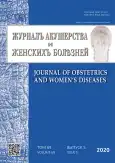Experience in surgical correction of genital prolapse caused by abdominoperineal operations for colon cancer in anamnesis
- Authors: Plekhanov A.N.1,2,3, Bezhenar V.F.1, Karachun A.M.4, Bezhenar F.V.2, Tsypurdeyeva A.A.5,6, Epifanova T.A.1,2
-
Affiliations:
- Academician I.P. Pavlov First Saint Petersburg State Medical University
- Saint Petersburg Clinical Hospital of the Russian Academy of Sciences
- Academy of Medical Education named after F.I. Inozemtsev
- N .N. Petrov National Medical Research Center of Oncology
- Saint Petersburg State University
- Research Institute of Obstetrics, Gynecology, and Reproductology named after D.O. Ott
- Issue: Vol 69, No 5 (2020)
- Pages: 87-97
- Section: Original study articles
- URL: https://journals.rcsi.science/jowd/article/view/56614
- DOI: https://doi.org/10.17816/JOWD69587-97
- ID: 56614
Cite item
Abstract
In recent studies, it has been established that extralevator abdominoperineal extirpation (ELAPE) of the rectum can improve the oncological results of treatment of distal rectal cancer compared to standard abdominoperineal extirpation. As a result of extralevator dissection, a large defect of the perineum is formed, which requires plastic closure. While performing ELAPE, the structures that form the pelvic diaphragm are affected. This increases the risk of pelvic organ prolapse in women and significantly affects the quality of life of these patients, which requires subsequent surgical treatment. Despite the fact that pelvic organ prolapse develops as a consequence of previous surgical treatment by an oncologist, they do not consider it as a complication in the long-term postoperative period. Such patients are not referred to the operating gynecologist. Currently, this problem is poorly understood and there are no standardized approaches to the surgical treatment of pelvic prolapse in this category of patients.
Full Text
##article.viewOnOriginalSite##About the authors
Andrey N. Plekhanov
Academician I.P. Pavlov First Saint Petersburg State Medical University; Saint Petersburg Clinical Hospital of the Russian Academy of Sciences; Academy of Medical Education named after F.I. Inozemtsev
Author for correspondence.
Email: bez-vitaly@yandex.ru
ORCID iD: 0000-0002-5876-6119
SPIN-code: 1132-4360
MD, PhD, DSci (Medicine), Professor. The Department of Obstetrics, Gynecology, and Neonatology; Chief Obstetrician-Gynecologist; Head of the Department of Operative Gynecology. Academy of Medical Education named after F.I. Inozemtsev
Russian Federation, Saint PetersburgVitaly F. Bezhenar
Academician I.P. Pavlov First Saint Petersburg State Medical University
Email: bez-vitaly@yandex.ru
ORCID iD: 0000-0002-7807-4929
SPIN-code: 8626-7555
MD, PhD, DSci (Medicine), Professor, Head of the Department of Obstetrics, Gynecology, and Neonatology
Russian Federation, Saint PetersburgAlexey M. Karachun
N .N. Petrov National Medical Research Center of Oncology
Email: dr.a.karachun@gmail.com
ORCID iD: 0000-0001-6641-7229
SPIN-code: 6088-9313
MD, PhD, DSci (Medicine), Associate Professor, Head of the Surgical Department of Abdominal Oncology, Leading Researcher, Head of the Scientific Department of Gastrointestinal Tract Tumors
Russian Federation, Saint PetersburgFyodor V. Bezhenar
Saint Petersburg Clinical Hospital of the Russian Academy of Sciences
Email: bez-vitaly@yandex.ru
ORCID iD: 0000-0001-5515-8321
SPIN-code: 6074-5051
MD. The Surgical Department
Russian Federation, Saint PetersburgAnna A. Tsypurdeyeva
Saint Petersburg State University; Research Institute of Obstetrics, Gynecology, and Reproductology named after D.O. Ott
Email: bez-vitaly@yandex.ru
ORCID iD: 0000-0001-7774-2094
SPIN-code: 5208-9707
MD, PhD, Assistant Professor. The Department of Obstetrics, Gynecology, and Reproductive Sciences, the Faculty of Medicine; Head of the Department of Gynecology with the Operating Unit
Russian Federation, Saint PetersburgTatyana A. Epifanova
Academician I.P. Pavlov First Saint Petersburg State Medical University; Saint Petersburg Clinical Hospital of the Russian Academy of Sciences
Email: bez-vitaly@yandex.ru
ORCID iD: 0000-0003-1572-1719
SPIN-code: 5106-9715
MD, Post-Graduate Student The Department of Obstetrics, Gynecology, and Neonatology; Obstetrician-Gynecologist. The Surgical Department
Russian Federation, Saint PetersburgReferences
- Каприн А.Д., Старинский В.В., Петрова Г.В. Злокачественные новообразования в России в 2015 году (заболеваемость и смертность). – М., 2017. – 249 c. [Kaprin AD, Starinskiy VV, Petrova GV. Zlokachestvennye novoobrazovaniya v Rossii v 2015 godu (zabolevaemost’ i smertnost’). Moscow; 2017. 249 p. (In Russ.)]
- National Comprehensive Cancer Network. NCCN Guidelines for Rectal Cancer Version 3. 2017. Available from: https://www2.tri-kobe.org/nccn/guideline/colorectal/english/rectal.pdf.
- Bullard KM, Trudel JL, Baxter NN, Rothenberger DA. Primary perineal wound closure after preoperative radiotherapy and abdominoperineal resection has a high incidence of wound failure. Dis Colon Rectum. 2005;48(3):438-443. https://doi.org/10.1007/s10350-004-0827-1.
- Pollard CW, Nivatvongs S, Rojanasakul A, Ilstrup DM. Carcinoma of the rectum. Profiles of intraoperative and early postoperative complications. Dis Colon Rectum. 1994;37(9):866-874. https://doi.org/10.1007/BF02052590.
- So JB, Palmer MT, Shellito PC. Postoperative perineal hernia. Dis Colon Rectum. 1997;40(8):954-957. https://doi.org/10.1007/BF02051204.
- Stelzner S, Sims A, Witzigmann H. Comment on Asplund. Outcome of extralevator abdominoperineal excision compared with standard surgery: Results from a single centre. Colorectal Dis. 2013;15(5):627-628. https://doi.org/10.1111/codi.12116.
- Xu HR, Xu ZF, Li ZJ. [Research progression of extralevator abdominoperineal excision. (In Chinese)]. Zhonghua Wei Chang Wai Ke Za Zhi. 2013;16(7):698-700.
- Sinna R, Alharbi M, Assaf N, et al. Management of the perineal wound after abdominoperineal resection. J Visc Surg. 2013;150(1):9-18. https://doi.org/10.1016/j.jviscsurg. 2013.02.001.
- Chokshi RJ, Kuhrt MP, Arrese D, Martin EW. Reconstruction of total pelvic exenteration defects with rectus abdominus myocutaneous flaps versus primary closure. Am J Surg. 2013;205(1):64-70. https://doi.org/10.1016/j.amjsurg.2012.04.010.
- West NP, Anderin C, Smith KJ, et al. Multicentre experience with extralevator abdominoperineal excision for low rectal cancer. Br J Surg. 2010;97(4):588-599. https://doi.org/10.1002/bjs.6916.
- Патент РФ на изобретение RU № 2636417 С2. Шинкарев С.А., Латышев Ю.П., Клычева О.Н. Способ закрытия дефекта тазового дна после экстралеваторной брюшно-промежностной экстирпации прямой кишки с использованием пластины ксеноперикардиальной «Кардиоплант». [Patent RUS No. 2636417 S2. Shinkarev SA, Latyshev YuP, Klycheva ON. Sposob zakrytiya defekta tazovogo dna posle ekstralevatornoy bryushno-promezhnostnoy ekstirpatsii pryamoy kishki s ispol’zovaniyem plastiny ksenoperikardial’noy “Kardioplant”. (In Russ.)]. Доступно по: https://yandex.ru/patents/doc/RU2636417C2_20171123. Ссылка активна на 17.04.2020.
- Плеханов А.Н., Беженарь В.Ф., Епифанова Т.А., Беженарь Ф.В. Сравнительная характеристика методов гемостаза при влагалищной гистерэктомии // Кубанский научный медицинский вестник. − 2019. − Т. 26. − № 6. − С. 61–69. [Plekhanov AN, Bezhenar VF, Epifanova TA, Bezhenar FV. Comparative characteristics of hemostasis during vaginal hysterectomy. Kubanskiy nauchny meditsinskiy vestnik. 2019;26(6):61-69. (In Russ.)]. https://doi.org/10.25207/1608-6228-2019-26-6-61-69.
Supplementary files
































